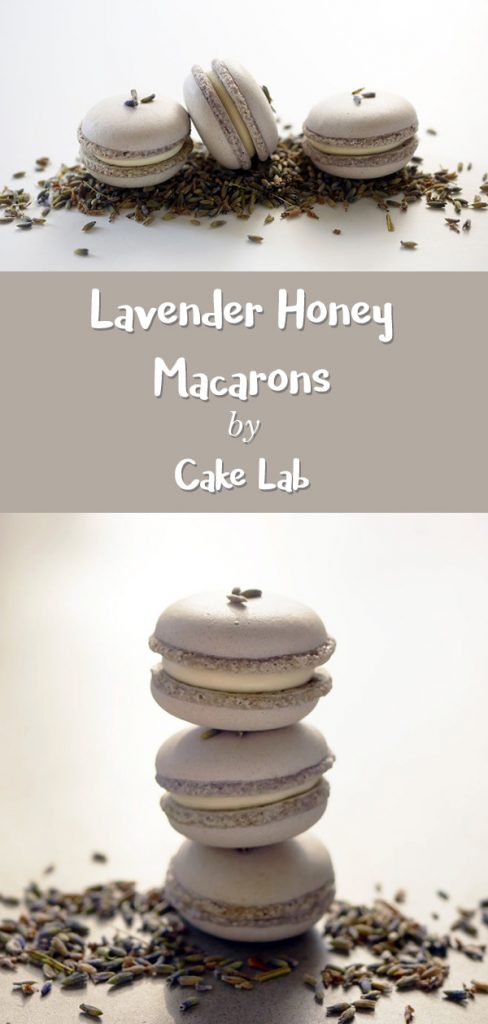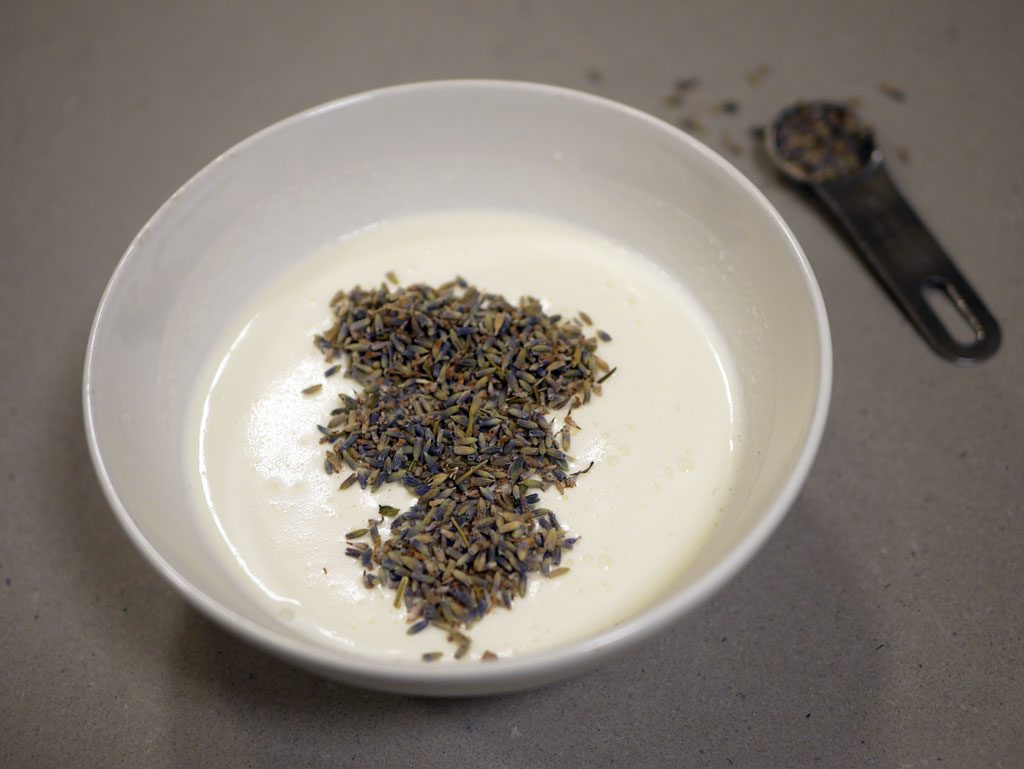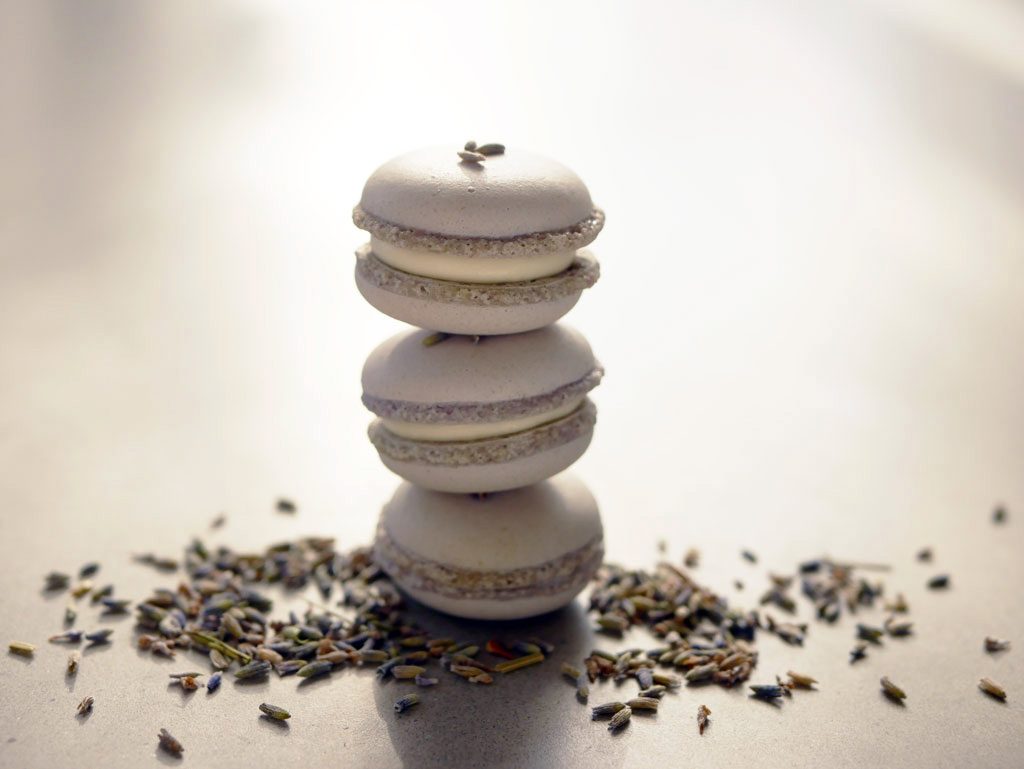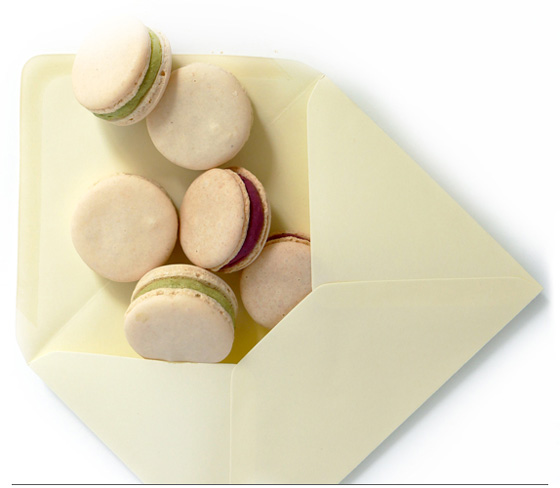Lavender Honey Macarons


Happy blogiversary to Cake Lab! My little blog is 2 years old. Two! It’s my favorite age. I mean, I don’t remember it myself, but my nephews and nieces are doing a great job showing me. I have so much fun with them at this age. It’s the age where they have already discovered how to walk and they start running. They already know how to talk and start asking questions non-stop. There are so curious, warm and full of life. And that’s what I wish for my blog this year. That it’ll behave just like my nephews and nieces at this age, just without all that crying.
I started this blog with macarons. To be exact, yuzu flavored macarons inspired by the French pastry chef Pierre Hermé. For the first blogiversary, I made double pistachio macarons, macarons with pistachios in the shell and in the filling. For the second blogiversary, I made… wait for it… macarons! You know, to keep up with tradition. Honey lavender flavored macarons. Sort of. It’s honey plus dried lavender flowers. I tried to look for actual lavender honey, just for the kick of it, but my search ended to no avail.
…
The body of the macaron, aka the cream, is made from whipped cream and mascarpone. It’s one of my favorite fillings. It makes the macaron so soft that it almost melts in your mouth. The only downside: they’re dangerously soft to travel with. They can be easily smooshed. Do not fear, there is a solution! Keep the macarons in the fridge and when it’s time to take them out just put them immediately in your mouth. Nah, not really. They keep pretty well at room temperature. They just don’t survive a long trip.
So yes, the macarons are lavender flavored. How do you do it? Simply soak the dried lavender flowers in the heavy cream overnight, strain it and you’ll get a wonderfully lavender scented heavy cream. And this is not the best part. I decorated the unbaked macaron shells with dried lavender flowers. The scent that enveloped the house while baking was intoxicating. It felt like spring in the middle of winter.





Ingredients
Macaron shells
200 g almond flour
200 g powdered sugar
75 g egg whites (for the meringue)
75 g egg whites (for the macaronage)
200 g sugar
75 g water
Purple food coloring (gel based)
Lavender honey chantilly
60 g mascarpone cheese
35 g condensed milk
35 g honey
120 g heavy cream
2 tsp dried lavender flowers
Decoration
Dried lavender flowers
Equipment
Thermometer
A pastry bag fitted with a smooth 8mm piping tip
The recipe makes about 50-60 scented macarons
Advance prep
Aging egg whites: One or even two days ahead, separate the whites from the yolks (easier when the eggs are cold), set aside the whites in a bowl and cover it with plastic wrap. Take a toothpick and punch a few holes in the plastic wrap, then put the bowl in the fridge.
In this process, some of the liquid from the egg whites evaporate, which makes for a nicer and smoother macaron shell. I recommend weighing a little more egg whites than the amount in the recipe, because the weight drops slightly after evaporation.
The day you bake the macarons, take out the egg whites bowl and wait for the egg whites to reach room temperature before whisking them.
Cold infusion: Put heavy cream in a bowl. Add 2 tsp dried lavender flowersand mix a little. Cover with plastic wrap and keep in the fridge overnight (about 12 hours). Mix well before use.
Shells
Mix almond flour and powdered sugar in a food processor for a minute or two (careful not to over-process, otherwise you’ll get a paste). Sift the mix in a sieve once, or better, twice. (The macaron shell will come out smoother that way). If there are any chunks that remain from the sifting, grind and sift them again. Set aside the bowl.
Italian Meringue:
Put water and then sugar in a saucepan. Place on medium/high heat. Stir the sugar with a spatula to dissolve it. Once the water starts to boil, stop stirring and remove the spatula. Let the syrup boil and check with a thermometer that the temperature does not exceed 115°C (240°F). While it’s boiling, whip 75 g egg whites in a mixer on medium speed. When the syrup reaches 105°C (220°F), increase the speed of the mixer so the egg whites get to soft peaks (white foam consistency). As soon as the syrup reaches 115°C (240°F), turn off the stove, reduce the mixer speed to medium, and slowly pour the syrup into the mixer. Increase the mixer speed to high and continue to whip for about 10 minutes, until the meringue cools.
Almond paste:
Add the other 75 g egg whites to the almond mixture. Mix well with a spatula until you get a viscous paste. Add 2-3 drops of purple food coloring. Mix until the paste is colored purple.
Macaronage:
This is a mix of the meringue with almond paste. This step is critical. Take a third of the meringue, add to the cream and mix with a spatula to loosen up the density of the cream. Gently fold in the rest of the meringue until you get a shiny, dense texture similar to lava or raw tahini. (Here’s how you know it’s ready: take a spoonful of the batter and throw it back into the bowl in rows.
After 10-15 seconds, the rows should sink into the mix but not flatten completely.) Make sure not to fold the batter too much, so it doesn’t get watery, which would make flat shells without the much desired “feet”. But also make sure not to fold too little, because then the macaron batter won’t flatten at all when you pipe, and it could rise and crack while baking. If you’re not sure, you can pipe a few test macarons, wait a minute and see if it stabilizes.
…
Fit a pastry bag with an 8 mm smooth tip and fill it with the batter. Prepare 3 or 4 baking sheets with straight, unfolded baking paper on top. Pipe a tiny bit of the batter on each corner of the baking sheet and “glue” the baking paper on top. Pipe circles of batter about 3 cm in diameter with a little space between each one. Tap the bottom of the baking sheet. If bubbles remain on the macaron shells, you can pop them gently with a toothpick.
Sprinkle a bit of dried lavender flowers on half of the macaron shells. Leave the baking sheets out in the kitchen for about 30-60 minutes (depending on the weather: it takes longer in winter and gets noticeably shorter in summer) until the shells develop a crust and is not sticky when you touch it with your fingertip. In the meantime, preheat the oven to 150°C (300°F).
Put the baking sheet in the oven and bake for 14 minutes. For uniform baking, flip the tray after about 7-8 minutes. Baking time depends on your oven. Bake a couple test macaron shells before you bake the rest of the batter. When you get the baking sheet out of the oven, immediately separate the baking paper with the macaron shells from the tray and place it on a cool surface (this makes it easier to remove the shells from the baking paper).
Wait for the shells to cool before removing. Arrange pairs of equal sized macaron shells. Flip over one shell with the flat side facing up.
Lavender honey chantilly
Put mascarpone cream, condensed milk and honey in the mixer bowl and whip well. The mixer won’t be able to bring it to a complete creamy texture. It will still be a little lumpy. To cream it, mix with a spatula and squash the lumps on the side of the mixer until uniform.
Pour the heavy cream into the mixer bowl through a sieve to get rid of the lavender flowers. Keep whipping until the mixture is smooth and firm. (Be careful not to over whip). Scrape the sides of the bowl now and then. Transfer the frosting into a pastry bag fitted with a 8 mm smooth piping tip. Use immediately.
Putting it all together!
Pipe a bit of chantily in the middle of each shell that is facing up. Put the second shell on top and gently squeeze so the chantilly spreads between them a bit. Keep the macarons in the fridge for 24 hours, so the flavors develop and the chantilly seeps into the shells and softens them.
Remove from the fridge about 15 minutes before serving to get a soft bite that melts in the mouth. The shells soften faster than usual because the filling is based on heavy cream. Which means that these macarons are dangerously soft, so you must handle them with care. Two days after sitting in the fridge, you may just eat the honey lavender macarons straight out of the fridge.

Tags In
Related Posts
Leave a reply:Cancel reply

Search the blog
![]()
Get updates by email












